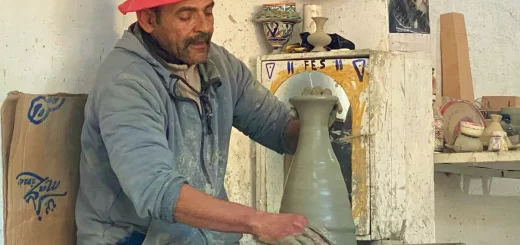Morocco immerses visitors in stories and scenes well beyond Sinbad and Aladdin
Myriad films and TV shows have been shot in North African nation

Janet Podolak, left, and Sascha Nelson keep their distance from an erect cobra in the Jemaa El-Fna square in Marrakech, Morocco. (Courtesy of a snake charmer in Morocco)
Stories are everywhere in Morocco, land of the Thousand and One Nights and origin of Aladdin, Sinbad the Sailor and Ala Baba.
And Morocco’s legacy of storytelling remains alive from Jemaa El- Fna, nerve center of Marrakech, to Atlas Studios in Ouarzazate, where films and television shows such as “The Jewel of the Nile,” “Game of Thrones” and “Gladiator” have been produced at the gateway to the Sahara Desert.
Jemaa El-Fna, a vast square bordering the Marrakech medina, throngs day into night with snake charmers, musicians and dancers and sellers of fruits and spices, all with stories to tell.
My daughter Sascha and I were there in February with six other Americans on a small group tour with Odysseys Unlimited led by guide Anouar Serhane, a native Moroccan who had never left his country. He’d hired another guide to assist him for our afternoon in the souks around Jamaa El-Fna so we could split up to shop and pursue our personal interests without becoming hopelessly lost in the 900 narrow alleys.
After seeing snake charmers in action, their flute tunes seeming to hypnotize cobras swaying upright, we wandered toward a rapt group sitting and standing around an animated storyteller. For more than a thousand years, storytellers have been among those finding their audiences in the square. Listeners leave behind tips to show their appreciation. We watched as the tellers wove their tales using their hands and voices, but without understanding the language, we missed the actual stories.
We’d come northeast to Marrakech from Ouarzazate, at the edge of the Sahara Desert, after crossing the multi-colored Atlas Mountains for three hours on winding but first-class roads. There, in southeast Morocco, modern-day storytelling is embodied at Atlas Studios.
On the way, we’d passed tiny villages, their mud houses tucked tightly into the clefts of treeless mountains, and seen a miles-long grove of date palms in a river valley, rare in this arid country.

Satellite dishes are the only indication that this village of mud and stone is an occupied settlement, not a stage set. (Janet Podolak)
Those at roadside stands, where we’d stopped to take photos, offered us fossils unearthed in the mountains, including black rock geodes cracked open to reveal sparkling amethyst insides.
Fossils tell their own ancient stories of long-ago volcanoes and today’s desert once being at a sea bottom.
Nature’s dramatic backdrops include the snow-capped Atlas Mountains, towering dunes and red-sand desert against startling blue skies, so it’s no surprise to discover that filmmaking began here in 1962 with “Lawrence of Arabia.” Twenty years later, the construction of Atlas Studios boosted the region’s economy and brought global attention to its landscapes with the production of the “Romancing the Stone” sequel “The Jewel of the Nile,” featuring Michael Douglas, Kathleen Turner and Danny Devito. Next came the 1986 shooting of “The Living Daylights,” the 15th James Bond film, starring Timothy Dalton.
Jobs as extras, translators, stuntmen and set workers brought prosperity and new residents to the region. In 1998, the blockbuster “Gladiator,” starring Russell Crowe, became its highest-impact film shoot. International stars such as Samuel L. Jackson, Jean-Claude Van Damme, Ben Kingsley, Nicole Kidman, Brad Pitt, Jean-Paul Belmondo and Leonardo Di Caprio have walked here and, according to guides, can sometimes be encountered among the sets that can be toured.
Sets on our tour took us to ancient Egypt, a Tibetan monastery, Biblical villages and scenes of Roman battles. Our guide showed us details in sets constructed for the effect of perspective on film, with sizes diminishing to replicate distance.
The set for director Ridley Scott’s 2005 historical drama, “Kingdom of Heaven,” was used earlier by the Hollywood director for his Academy Award-winning “Gladiator.” He also used the set for “Gladiator II,” the sequel set for theaters in November.
The “Kundun” set — named after its 1997 use in the Martin Scorsese Tibetan drama — doubled as the Mongolian desert for the 2010 Ed Harris-Colin Farrell prisoner-of-war drama “The Way Back.”

The “Kundun” set was named after its 1997 use in the Martin Scorsese-directed Tibetan drama. (Courtesy of Atlas Studios)
The Egyptian set — first used for the 1999 hit film “The Mummy” starring Brendan Fraser — subsequently appeared in the 2002 French-German fantasy-comedy sequel “Asterix & Obelix: Mission Cleopatra” starring Gerard Depardieu.
Popular TV series are part of the mix, including many scenes from “Games of Thrones.” The guide for our hour-long tour showed us his cell phone picture as a member of the Unsullied in “Game of Thrones.”

Our backstage guide at Atlas Studios shows a selfie of himself as an extra playing a member of the Unsullied in ‘Game of Thrones.” (Sascha Nelson)
It’s possible for visitors to arrange becoming extras themselves, especially those who book a stay at the Oscar Hotel, which offers many interactive adventures in and around Atlas Studios, along with rooms that seem like a film set. Film shoots in progress customarily are avoided by tours, but it’s not uncommon to encounter actors in costume, especially for visitors who book a stay at the hotel, which is on the premises.
Many stories were told by folks from our hotels on this Morocco visit, including those about fossils embedded in the floors and furnishings at Le Palais du Desert Hotel in Erfoud. Bountiful breakfast buffets told the story of a land with an abundance of fruit, especially dates.
Read my earlier Morocco stories highlighting shopping and food and creatures. Get background and information about the country from the Morocco National Tourist Office at visitmorocco.com/en. Learn more about Atlas Studios and the Oscar Hotel.





Recent Comments